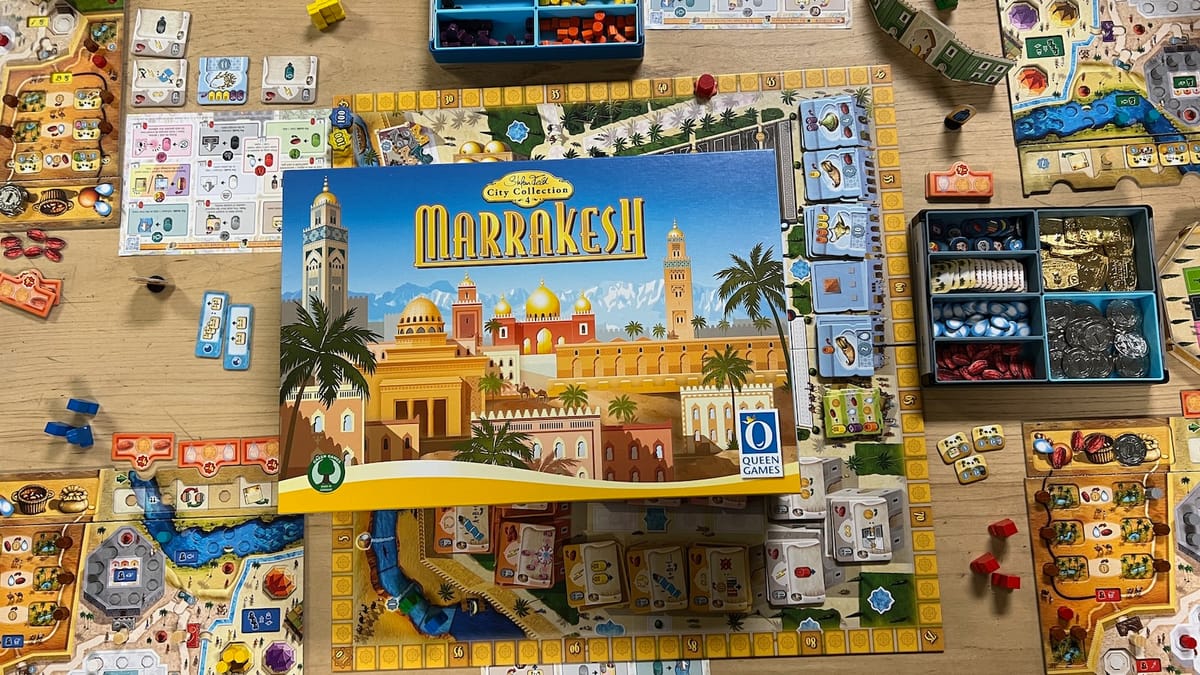
When it comes to North African cities, I’ll admit, my geographical prowess is a bit lacking. Using one of these cities as a basis for a game is not something that would immediately catch my eye. However, after seeing plenty of posts make their rounds on various social media platforms, I was excited to get Marrakesh to the table. Let me tell you, the game didn’t disappoint.
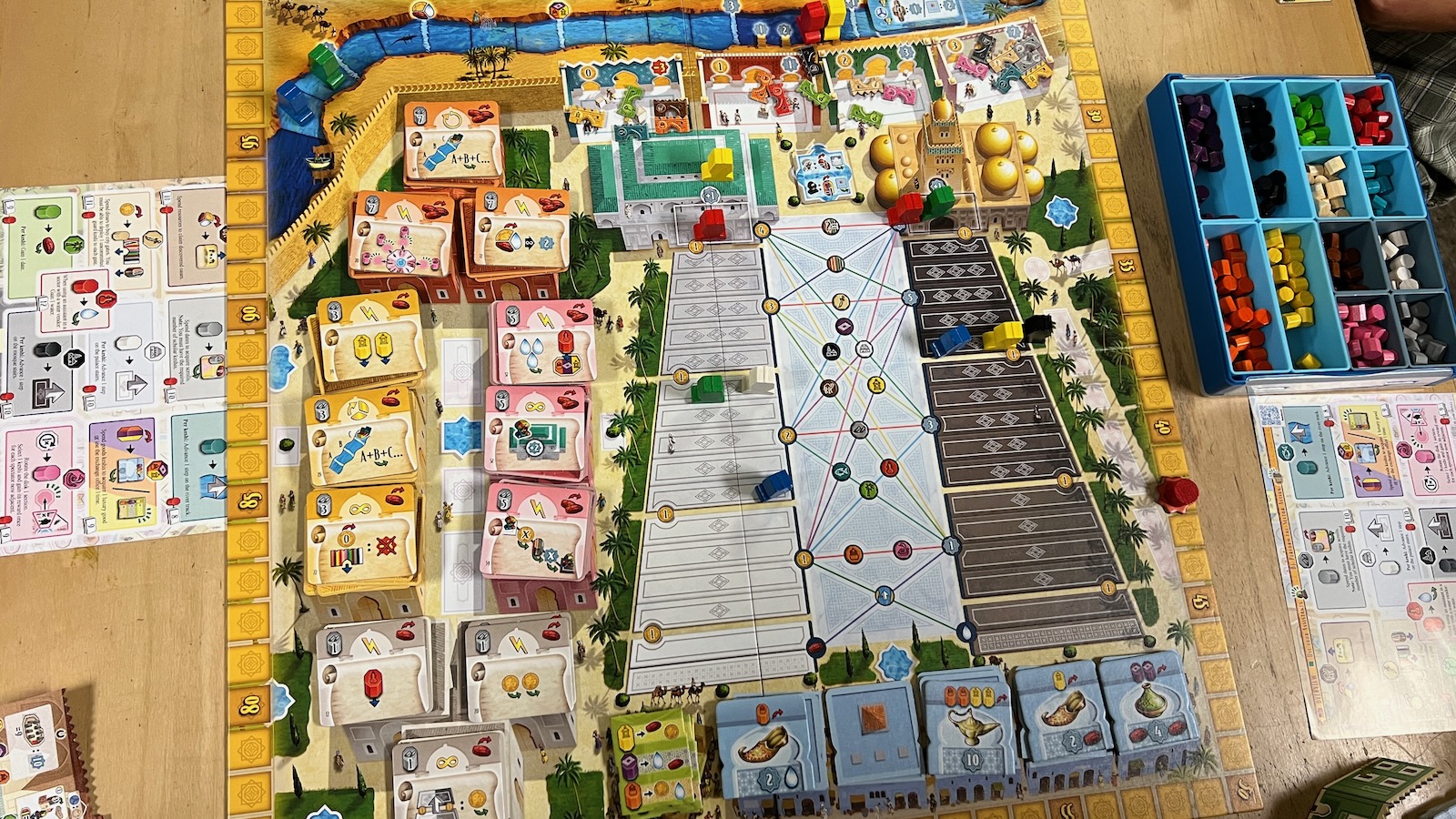
Classic edition main game board.
Marrakesh was released in 2022 as the fourth game in designer Stefan Feld’s City Collection. It joins other city games such as Hamburg, Amsterdam, and New York. In 2023, publisher Queen Games released a new repackaged version of the game as Marrakesh: Essential Edition. The gameplay was the same as the original, but with some changed components repackaged into a standard sized game box. In this review, I’ll explain the gameplay of both versions and go over the production differences in a different section.
How to Play
In Marrakesh, 2-4 players are vying to be the most influential family in the city. Gameplay takes place over 3 seasons, each with four rounds consisting of player turns divided into different phases. It is much easier to explain when you get into the game. There are also different end-of-round and end-of-season actions taken throughout the course of the game.

Players select keshis corresponding to the actions they would like to take for the round.
The most significant components of the game are colored tokens called keshis, which represent different areas of influence the family can use to improve their station within the city. At the beginning of each season, players are given 12 different colored keshis tied to different areas of their player board and the main board. Keshis are used to track upgrades, take actions, and even to buy goods depending on their color. Most of the game is played on the player boards where actions are tracked and different areas activated throughout the game. The main board houses the main scoring track, two tracks corresponding to the mosque and the palace, a river track, and various spots housing tiles that can be obtained through various actions.
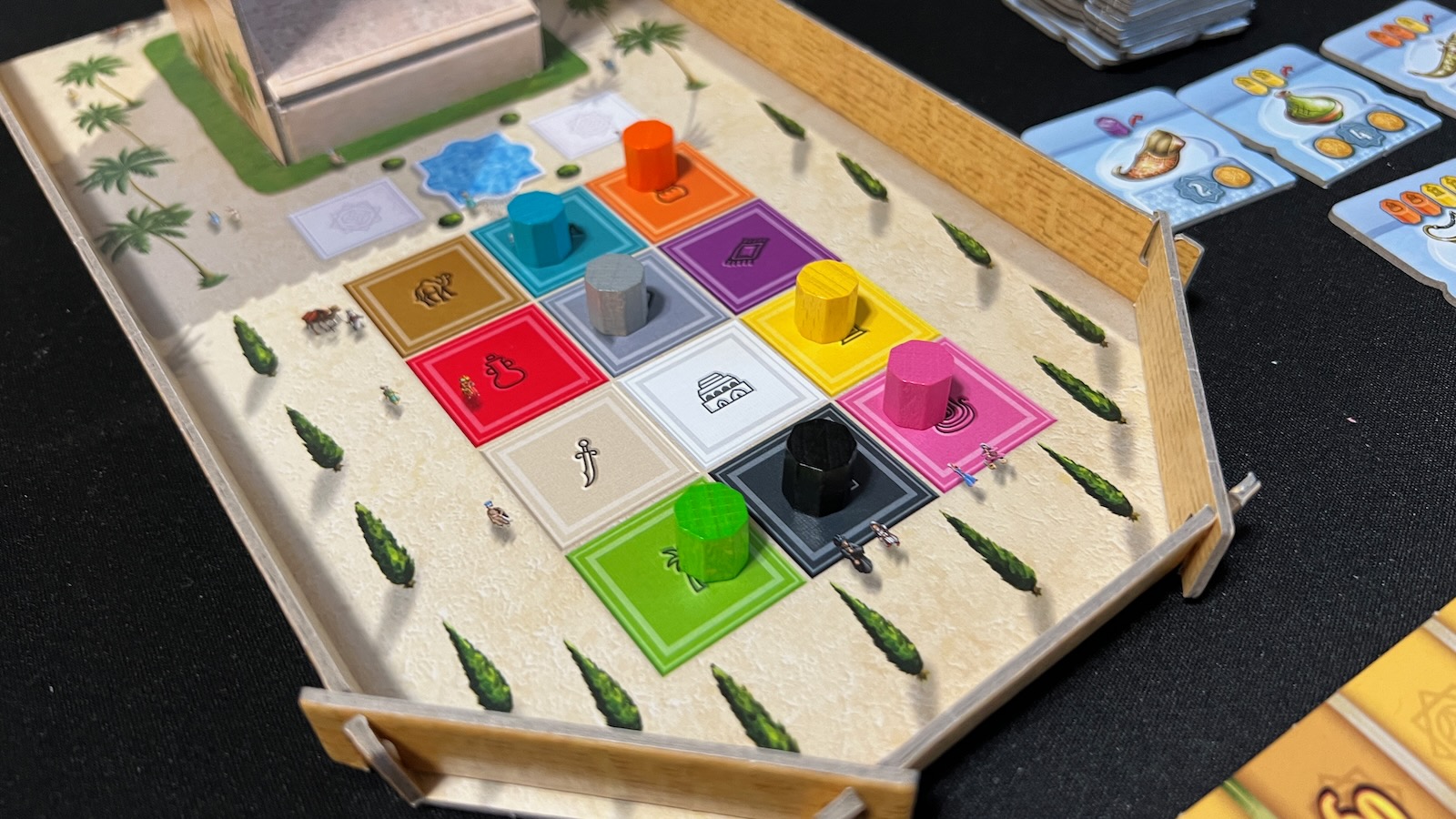
Keshis being sorted after coming out of the tower.
Turns are taken in three phases. In the first phase, players choose three keshis from behind a privacy screen. Once everyone has chosen, the players will reveal their keshis and place their three workers on the spaces of their player board corresponding to the colors. In the second phase, one player will take all the chosen keshis and drop them through the top of a tower. Whatever keshis come out of the bottom, whether from this turn or previous turns, will then be separated by color. In turn order, players will draft up to two keshis of the same color and power up the corresponding colored area on their board. Some of these placements will grant placement bonuses, but most of the placements power up player actions. After all the keshis have been drafted and placed, phase three begins. In phase three, players will use their placed worker pawns to take the action of the board area or power up the area for future turns. At the end of all player’s turns, end of round bonuses will be assessed and the phases will start again. After four turns, end of season bonuses will be assessed until three seasons have been completed and the game ends.
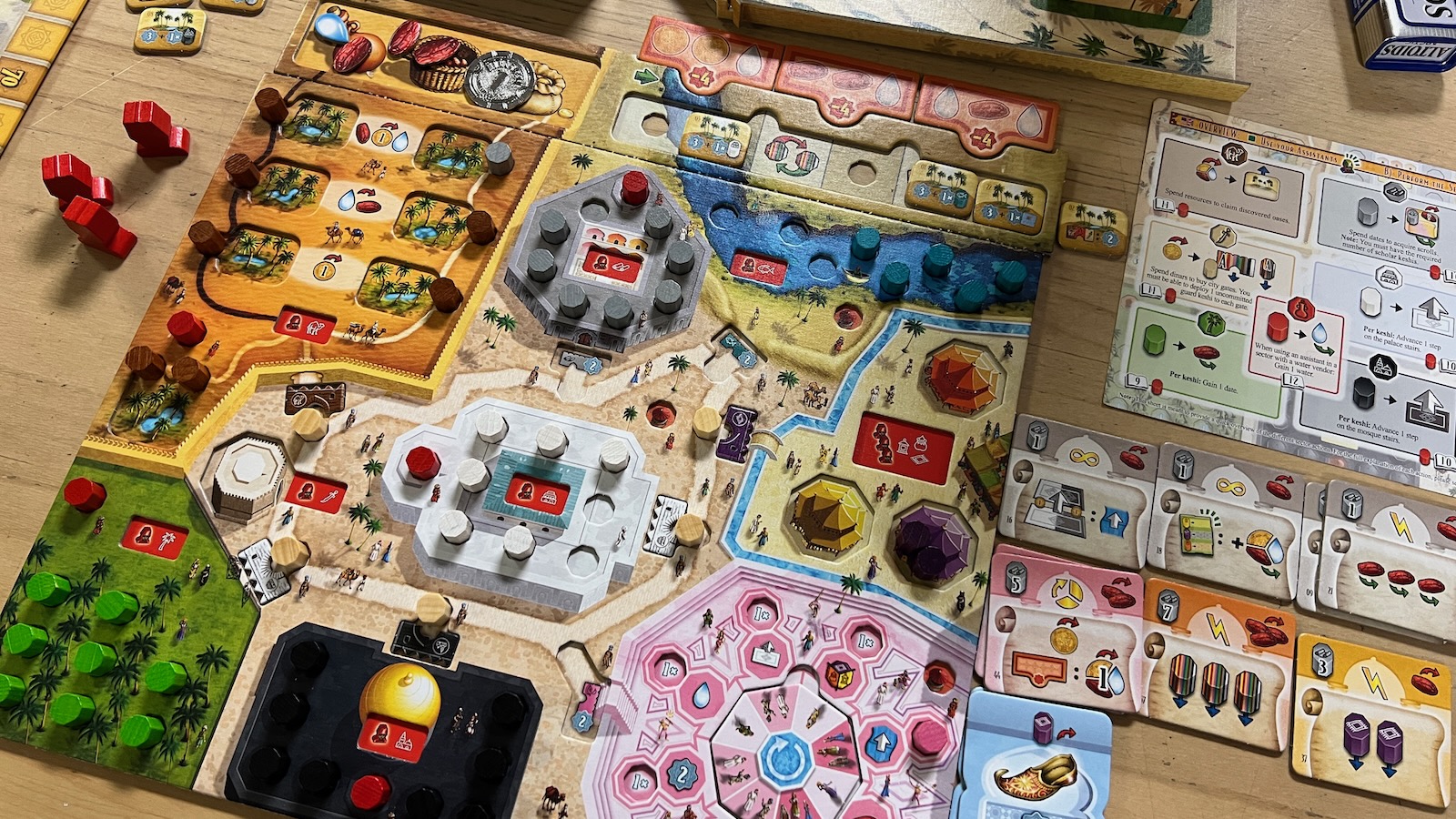
Classic edition player board toward the end of the game.
The real meat of the game comes in how you manipulate the keshis and the order of your actions. Many of the areas build up an engine to make actions more powerful given the number of keshis collected. For example, a green keshi gains you a point when collected and, when taking an action in the green date orchard section, you will collect a number of date resources equal to the amount of green keshis you have collected throughout the game. This also comes into play when activating the mosque, palace, and river areas by moving pawns up different tracks corresponding to the number of keshis collected in each section. Each section has its own unique aspects that help you gain points.
- Green – collect dates to spend in different areas on the board
- Blue – move up a special river track to help you collect bonuses at the end of each round and season. Spending water resources can increase your movement.
- Pink – rotate a wheel and activate bonuses with pink keshis. The wheel has different multipliers so timing this action can lead to some big bonuses.
- Yellow, Purple, Orange – spend these keshis to acquire luxury goods or exchange them for resources using the current seasonal exchange rate
- Gray – these keshis represent knowledge and can be spent on one time, ongoing, end of round, or end of season effect tiles. Players will also discard a number of dates corresponding to the power of each tile.
- White, Black – these keshis allow pawns to move up on two adjacent tracks. Bonuses are granted as pawns move into the new sections corresponding to the position of the pawn on the adjacent track.
- Tan – tan keshis represent guards and allow players to buy colored gates to guard each section of their board. Players gain new keshis corresponding to the color of the gate chosen and bonus points when gates match the color of the section they are guarding.
- Brown – these keshis allow players to unlock end of game scoring conditions or extra bonuses. Taking an action here activates one of the revealed conditions and grants the player a bonus after paying a small fee. Players are able to score three of their unlocked and activated end game scoring tiles.
- Red – these keshis allow players to place their workers on any of the above action spaces. When drafted, players will add red keshis to the other sections of the board, giving players a water resource when that section is activated in the future.
At the end of each round, special bonuses are given to players who have moved up the river track and the first player marker is shifted. At the end of the season, the player who moved up the river the farthest gets a special bonus such as a free action, free keshis, or extra points, all of which are part of the randomized set-up of the game. Players must also spend an increasingly larger amount of resources to provide for their people. Failure to do so will result in the loss of points and all remaining resources.
At the end of the game, players will score up to three of their unlocked end game conditions, points based on left over resources, and points for sections of their board that have been fully upgraded by keshis with a red keshi included.
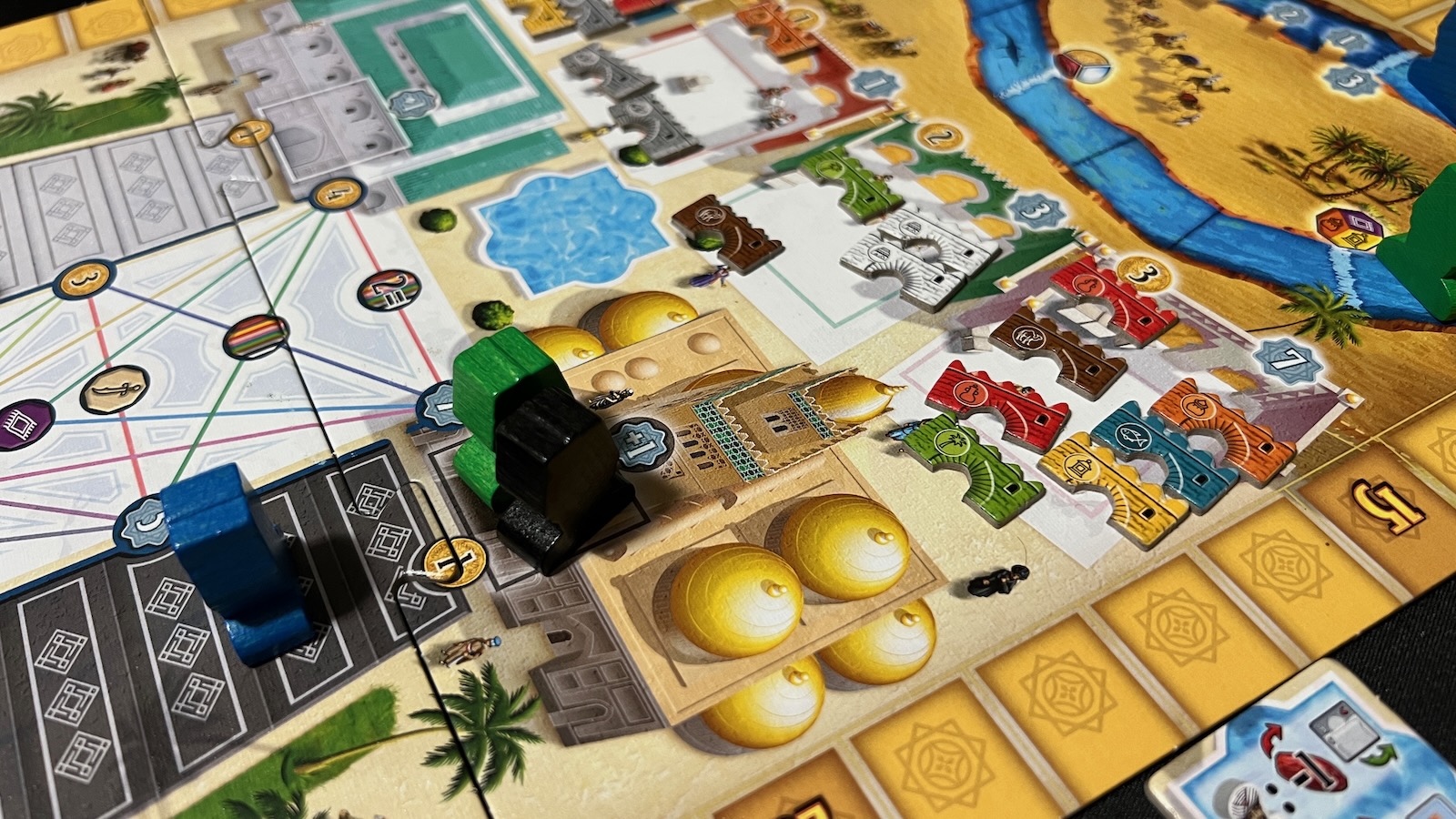
Essential Edition main board featuring the tracks, the gate market, and the Sultan/Imam expansion.
Included in the base game are also five small expansions that mostly add some more variance to aspects of the game. Expansion one randomizes the bonuses between the palace and mosque tracks, and expansion two adds an Imam and Sultan to their respective tracks, giving players discounts when buying tiles. Expansion three adds more exchange offices for players to use their orange, yellow, and purple keshis with, and expansion four changes the wheels used in the pink section of the boards, making it more varied and difficult. The last expansion changes the brown desert section of the board. First, the tiles giving immediate bonuses are blocked, then a number of desert town tiles are added to a communal area. If activated by a brown keshi, players can choose one of these tiles from the community pile and can activate these end game tiles when taking an action.
Gameplay

Main board of the classic edition.
I’m not going to lie, this game hurt my brain in all of the best ways! The more you play the game, the more you start to see the synergies that can be created between the different sections of the board. However, even though you may know what tiles you want to go after in the market or what bonuses you could get by taking a strategic mosque or palace action at the right time can all be turned on its head by the sheer amount of variability in the set-up or by throwing in one of the expansions. This sort of variability makes players adapt to the conditions they find rather than finding the winning combination of moves and gaming the game.
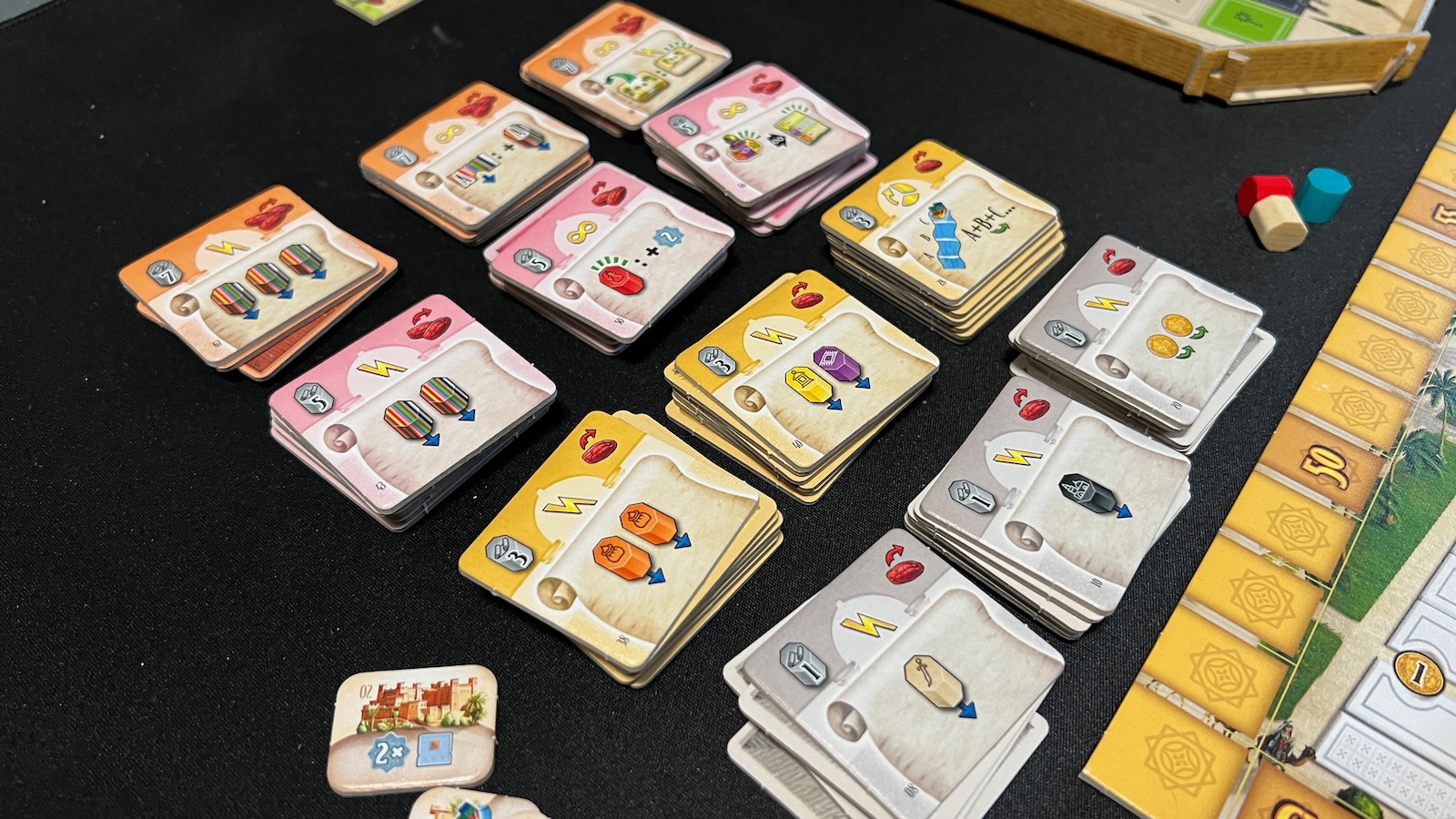
Scholar tiles for purchase from the Essential Edition.
This is a game where order of operations matters. Players have essentially three actions each round to create a winning formula. The order in which you take your actions can lead to cascading effects. For example, going to market can get you resources needed to buy multiple end game tiles from the brown section. When activating these tiles, you may unlock a new keshi that makes your final action stronger.
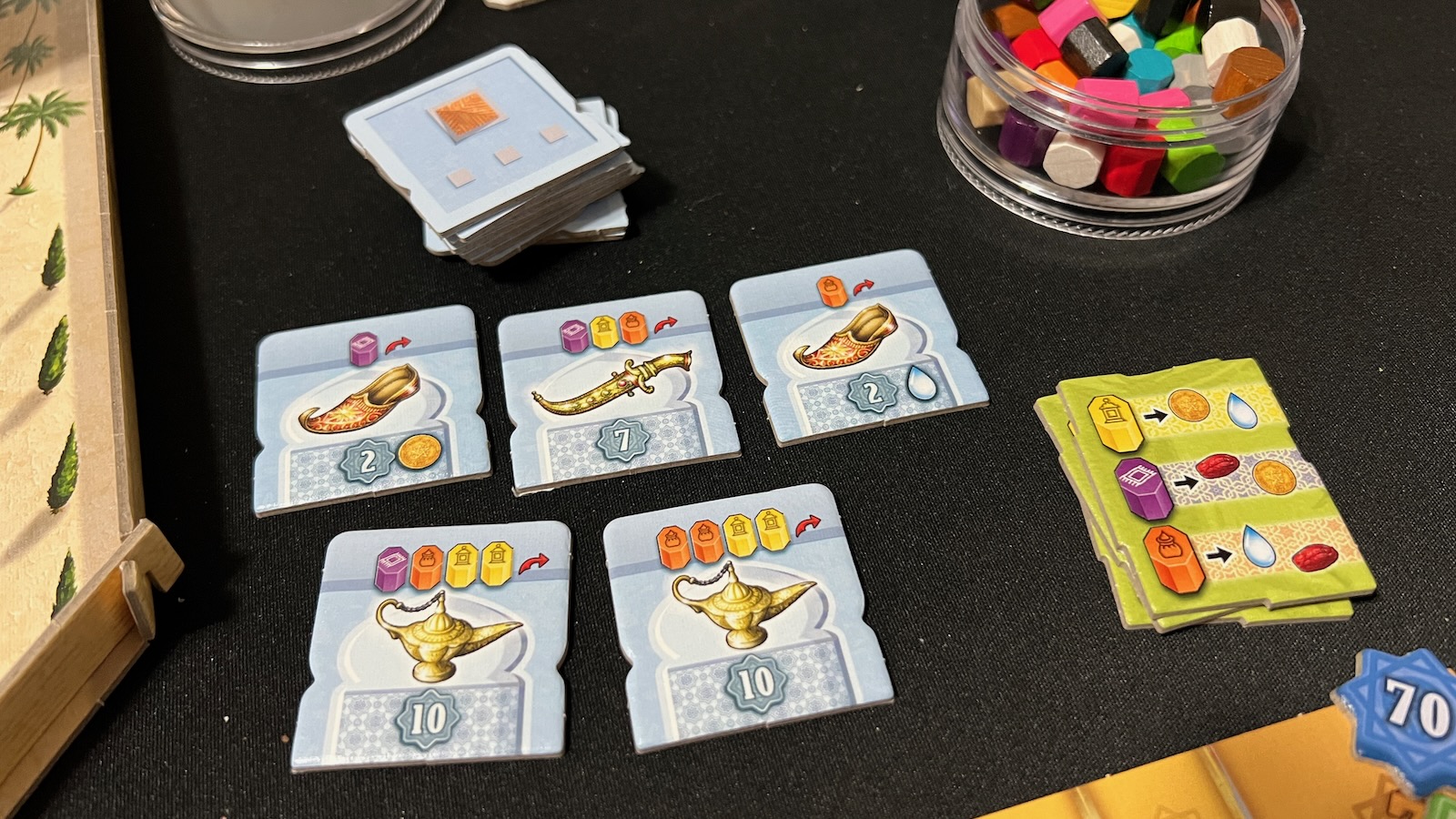
Essential edition market tiles.
Another condition of the game is the other players. What actions, of the twelve available, another player chooses can completely change the make up of what keshis go into the tower. Even when you drop the keshis in, the tower is designed to block some of the keshis from all coming out. Your turn order can affect your draft position and even help or hinder getting some of the bonuses by moving up a track first or getting something from the market before your opponent. Turn order can also telegraph actions to other players, allowing them to swoop in first to take something you wanted, or bide their time and strike at the last minute. The game also plays differently at different player counts, but each is fun and scales well. More players allows more variability of potential keshis to draft, but a two player game can be a quicker and tighter experience.
Components
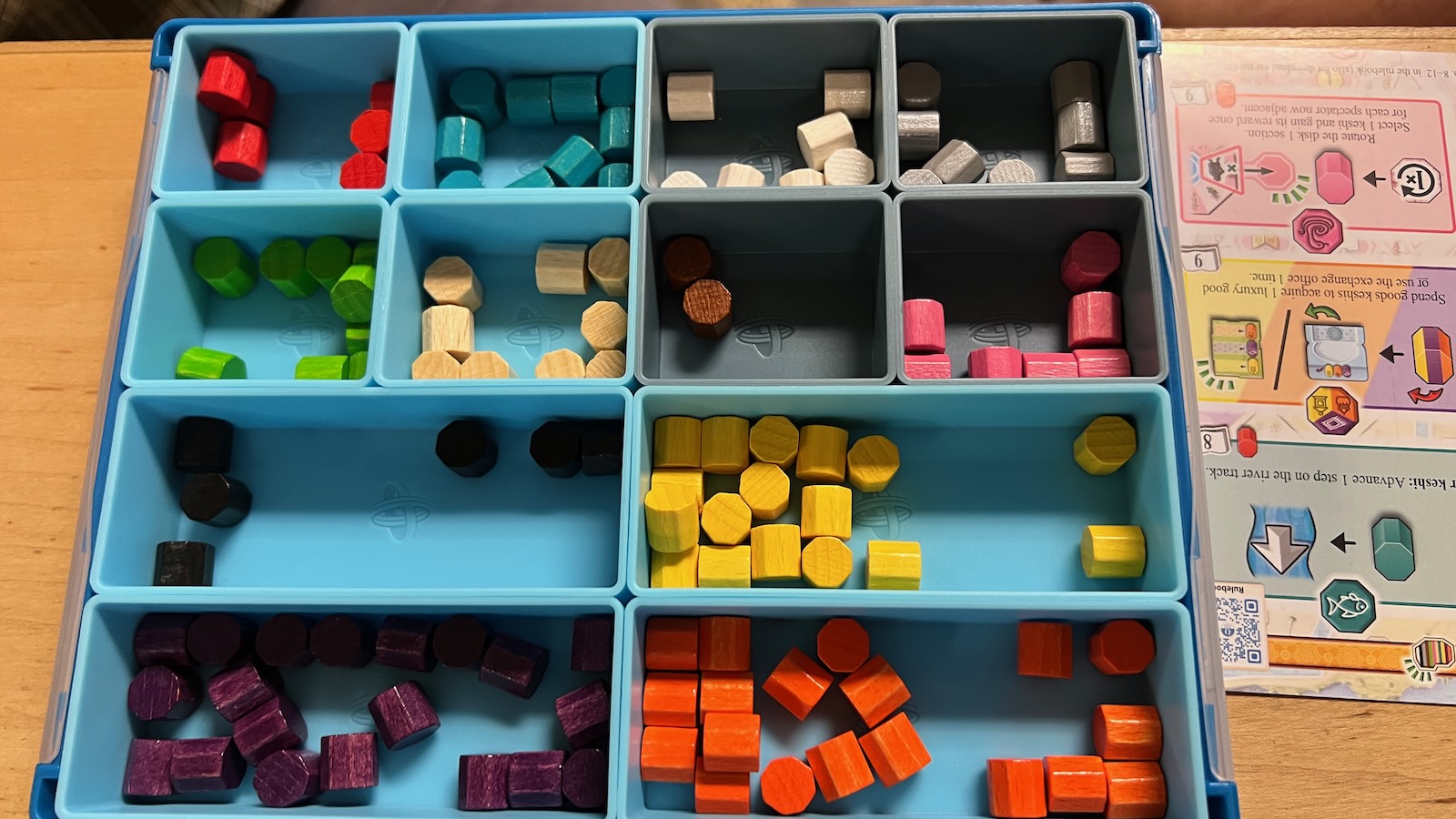
General supply of keshis in an organizer from the Classic Edition.
This section varies greatly depending on the version you pick up. I was able to play both Marrakesh: Standard Edition and Marrakesh: Essential Edition. Seeing as how the gameplay doesn’t change between versions, let me tell you about the component differences.
The Standard Editon is the way the game was originally released and comes with a larger box to house all the components. Every keshi in the game is a wooden token. When drafting keshis, players will slot them into a dual layered player board. These dual layers give recesses for keshis, worker tokens, and resources. The main board is large enough to house spaces for all of the tiles players can purchase throughout the game.
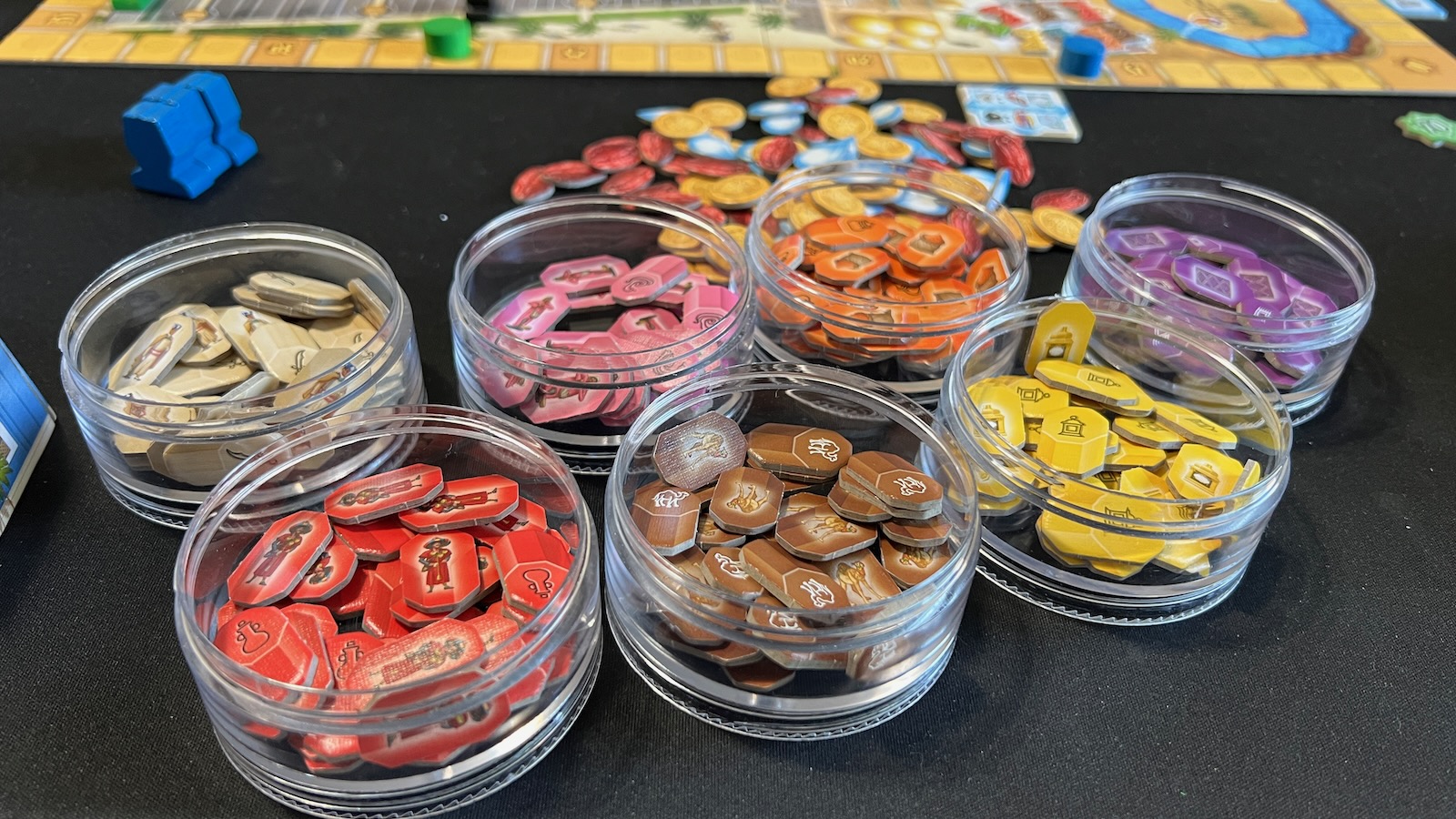
Keshi supply from the Essential Edition.
The Essential Edition is basically a more stripped down and more economical version of the game. Everything has been shrunk down to fit everything into a standard sized box including the player boards, the main board, and the tiles for purchase. One of the biggest differences comes in the keshis themselves. While still including some wooden keshis, for the action selection and drafting phases, most of the keshis are traded in for cardboard or tracks using a marker. When drafted, players will swap the wood pieces out for cardboard tiles or move a wooden keshi up a track. The redesigned player boards are single layered and have been reduced in size to make the experience more compact. Another element that has been scaled down is the main board holding the river, mosque, palace, and point tracks. This board is still functional for those purposes, but the parts of the board holding the scroll tiles and the luxury goods have been taken off, leaving players to create stacks on the table.
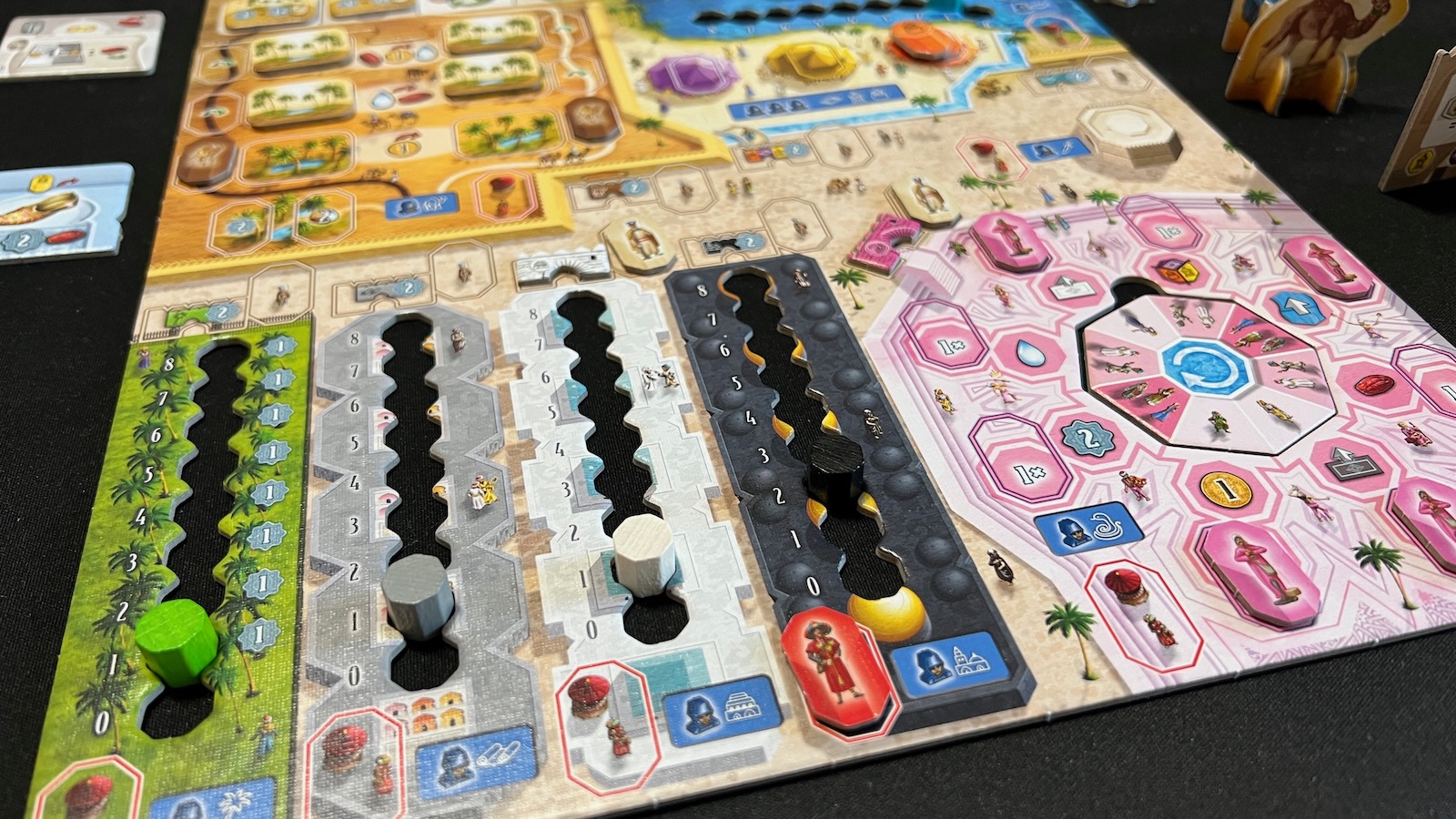
Essential Edition player board featuring action tracks.
The original edition of Marrakesh is a fun experience with the dual layered boards and the fantastic design of the main board. The essential edition can get fiddly when having to trade out your wooden components for cardboard that sits on top of the board. One nice touch to these cardboard tokens though, is the artwork that represents the people of the city on one side, rather than looking at a 3D representation of a wooden token on the other. At the end of the day, the Essential Edition is perfect for those wanting the deep gameplay without shelling out the retail $120 dollars for the main game. However, I would still rather play with the original version components any day. It should also be noted there are even more wooden upgrade bits and metal coins available and an upcoming expansion for both versions of the game expanding gameplay.

The palace and mosque track and the bonuses between the two.
Overall, Marrakesh is something special. It has been awhile since I’ve played such a strategic game that I’ve immediately wanted to play again, even after a brain burning previous session. The variability of the set-up allows for a different experience every session and forces players to adapt to the conditions on the board rather than gaming the game with repeated strategies. This is one that will come out frequently in my household.
Marrakesh
Excellent
A point salad with legs. Select and draft keshi tokens to power up your actions to become the most influential family in Marrakesh. A deep game with variable strategies to achieve victory. Different versions for different wants, but either way, a great addition to the tabletop game space.
Pros
- Fun action selection, drafting, and engine building mechanics that work well throughout the game
- Variability of set-up and player counts make for new exciting experiences each playthrough
- Redesigned components make essential edition more compact and affordable without losing gameplay
Cons
- Price tag for the classic edition is a bit hefty
- Essential Edition components are lackluster after playing the original edition
- A lot of choices could lead to some analysis paralysis
